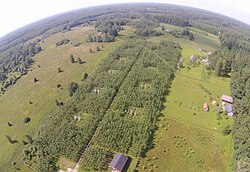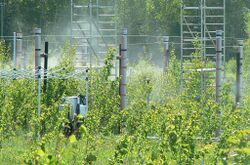Earth:Free Air Humidity Manipulation
There do not appear to be enough references currently present in this article to demonstrate notability. However, an editor has performed a search and claims that there are sufficient sources to indicate that this is a notable topic. (May 2020) (Learn how and when to remove this template message) |
}}
Free Air Humidity Manipulation (FAHM) experiment[1][2] is a large-scale field experiment in Estonia,
FAHM was established by plant biologists (ecophysiologists and applied ecologists) of the University of Tartu to investigate the long term effects of increasing air humidity on tree performance and on the functioning of the deciduous forest ecosystem. The design of the FAHM experiment is based on the Free Air Carbon dioxide Enrichment (FACE) technology.
FAHM (58°14′N, 27°18′E) is located within the Järvselja Training and Experimental Forest District in the village of Rõka, Tartu county, FAHM infrastructure enables to increase air relative humidity up to 18% unit above ambient level (long-term mean increase 7%).
References
- ↑ Kupper, P.; Sõber, J.; Sellin, A.; Lõhmus, K.; Tullus, A.; Räim, O.; Lubenets, K.; Tulva, I. et al. (2011). "An experimental facility for Free Air Humidity Manipulation (FAHM) can alter water flux through deciduous tree canopy". Environmental and Experimental Botany 72 (3): 432–438. doi:10.1016/j.envexpbot.2010.09.003.
- ↑ "FAHM homepage". http://fahm.ut.ee/main?lang=en.
[ ⚑ ] 58°14′44″N 27°17′59″E / 58.2455°N 27.2996°E
 |



